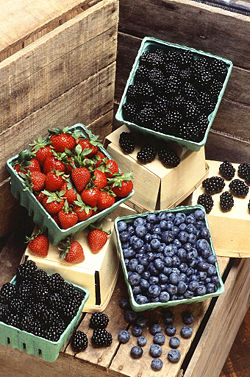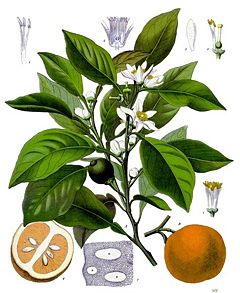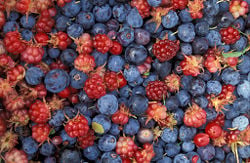Difference between revisions of "Berry" - New World Encyclopedia
Rick Swarts (talk | contribs) |
Rick Swarts (talk | contribs) |
||
| Line 29: | Line 29: | ||
| accessdate = 2007-07-31 | | accessdate = 2007-07-31 | ||
}}</ref> | }}</ref> | ||
| + | |||
| + | |||
| + | ==Fruit and fruit development== | ||
| + | In [[botany]], a ''fruit'' is the ripened ovary—together with [[seed]]s—of a [[flowering plant]]. | ||
| + | |||
| + | In flowering plants (angiosperms), an ovary is a part of the female reproductive organ of the [[flower]]. Specifically, it is the part of the carpel that holds the ovule(s). A carpel is the outer, often visible part of the female reproductive organ of a flower and contains the stigma, the style, and the ovary. The ovary contains the female reproductive cell or ovule. | ||
| + | |||
| + | After [[pollination]], the ovary will grow into the fruit, while the ovule(s) become the seed(s). In many [[species]], the fruit incorporates the ripened ovary and surrounding tissues. | ||
| + | |||
| + | More specifically, after an ovule is fertilized in a process known as pollination, the ovary begins to expand. The petals of the [[flower]] fall off and the ''ovule'' develops into a [[seed]]. The ovary eventually comes to form, along with other parts of the flower in many cases, a structure surrounding the seed or seeds that is the fruit. Fruit development continues until the seeds have matured. With some multiseeded fruits the extent of development of the flesh of the fruit is proportional to the number of fertilized ovules. | ||
| + | |||
| + | The wall of the fruit, developed from the ovary wall of the flower, is called the ''pericarp.'' The pericarp is often differentiated into two or three distinct layers called the ''exocarp'' (outer layer—also called epicarp), ''mesocarp'' (middle layer), and ''endocarp'' (inner layer). | ||
| + | |||
| + | Fruits are so varied in form and development that it is difficult to devise a classification scheme that includes all known fruits. It also will be seen that many common terms for [[seed]]s and fruit are incorrectly applied, a fact that complicates understanding of the terminology. Seeds are ripened ovules; fruits are the ripened ovularies or carpels that contain the seeds. | ||
==Botany== | ==Botany== | ||
Revision as of 19:47, 4 August 2007
The term berry, in common parlance and in cuisine, refers generically to any small, edible fruit with multiple seeds. Aggregate fruits such as the blackberry, the raspberry, and the boysenberry are also berries in this sense, but not the botanical.
These fruits tend to be small, sweet, juicy, and of a bright color contrasting with their background to make them more attractive to animals that eat them, thus dispersing the seeds of the plant.
As berry colors derive from natural pigments synthesized by the plant, a special field of health research[1] has focused on the anti-disease properties of pigmented polyphenols, such as flavonoids, anthocyanins, and tannins among other phytochemicals localized mainly in berry peels (skins) and seeds. Related to the biological properties of berry pigments is antioxidant ability for which berries are notable due to their relatively high oxygen radical absorbance capacity ("ORAC") among plant foods.[2] Together with good nutrient content, ORAC distinguishes several berries within a new category of functional foods called "superfruits", a rapidly growing multi-billion dollar industry which began in 2005.[3]
Fruit and fruit development
In botany, a fruit is the ripened ovary—together with seeds—of a flowering plant.
In flowering plants (angiosperms), an ovary is a part of the female reproductive organ of the flower. Specifically, it is the part of the carpel that holds the ovule(s). A carpel is the outer, often visible part of the female reproductive organ of a flower and contains the stigma, the style, and the ovary. The ovary contains the female reproductive cell or ovule.
After pollination, the ovary will grow into the fruit, while the ovule(s) become the seed(s). In many species, the fruit incorporates the ripened ovary and surrounding tissues.
More specifically, after an ovule is fertilized in a process known as pollination, the ovary begins to expand. The petals of the flower fall off and the ovule develops into a seed. The ovary eventually comes to form, along with other parts of the flower in many cases, a structure surrounding the seed or seeds that is the fruit. Fruit development continues until the seeds have matured. With some multiseeded fruits the extent of development of the flesh of the fruit is proportional to the number of fertilized ovules.
The wall of the fruit, developed from the ovary wall of the flower, is called the pericarp. The pericarp is often differentiated into two or three distinct layers called the exocarp (outer layer—also called epicarp), mesocarp (middle layer), and endocarp (inner layer).
Fruits are so varied in form and development that it is difficult to devise a classification scheme that includes all known fruits. It also will be seen that many common terms for seeds and fruit are incorrectly applied, a fact that complicates understanding of the terminology. Seeds are ripened ovules; fruits are the ripened ovularies or carpels that contain the seeds.
Botany
In botany, the berry is the most common type of simple fleshy fruit; a fruit in which the entire ovary wall ripens into an edible pericarp. The flowers of these plants have a superior ovary and they have one or more carpels within a thin covering and very fleshy interiors. The seeds are embedded in the common flesh of the ovary. Examples of botanical berries include the tomato, grape, litchi, loquat, plantain, avocado, persimmon, eggplant, guava, uchuva (ground cherry), and chile pepper.
The fruit of citrus, such as the orange, kumquat and lemon, is a modified berry called a hesperidium. The fruit of cucumbers and their relatives are modified berries called "pepoes". A plant that bears berries is referred to as bacciferous.
Fruits of all members of the genus Citrus are considered berries because they have many seeds, are fleshy and soft, and derive from a single ovary. The distinctive fruit is a hesperidium in that it is a specialized berry with the internal fleshy parts divided into segments (typically 10 to 16) and surrounded by a separable rind (Katz and Weaver 2003).
| Botanical parlance | |||||
|---|---|---|---|---|---|
| Berry | Pepo | Hesperidium | Not a berry | ||
| Common parlance | Berry | Grape, Currant, Cranberry, Blueberry, Banana, Gooseberry | Strawberry, Blackberry, Raspberry, Boysenberry | ||
| Not a berry | Tomato, Persimmon, Eggplant, Guava, Chili pepper, Pomegranate, Avocado, Kiwifruit, | Squash, Pumpkin, Gourd, Cucumber, Melon, Cantaloupe, Watermelon | Orange, Lemon, Lime, Grapefruit | Apple, Peach, Cherry, Green bean, Sunflower seed | |
Notes
- ↑ Gross PM (2007-07-09). "Scientists zero in on health benefits of berry pigments". Natural Products Information Center. Retrieved 2007-07-31.
- ↑ Wu X, Beecher GR, Holden JM, Haytowitz DB, Gebhardt SE, Prior RL (2004-06-16). "Lipophilic and hydrophilic antioxidant capacities of common foods in the United States". J Agric Food Chem 2004 Jun 16;52(12):4026-37.. Retrieved 2007-07-31.
- ↑ Gross PM (2007-02-26). "Superfruits take center stage: Defining an emergent categry". Natural Products Information Center. Retrieved 2007-07-31.
- Katz, S. H., and W. W. Weaver. 2003. Encyclopedia of Food and Culture. New York: Schribner. ISBN 0684805685.
See also
- List of fruits
- Epigynous berry
External links
- The National Council for the Conservation of Plants and Gardens - Description of berries
- Encarta.msn.com - Differentiation between true berries, pepos, and hesperidia
Credits
New World Encyclopedia writers and editors rewrote and completed the Wikipedia article in accordance with New World Encyclopedia standards. This article abides by terms of the Creative Commons CC-by-sa 3.0 License (CC-by-sa), which may be used and disseminated with proper attribution. Credit is due under the terms of this license that can reference both the New World Encyclopedia contributors and the selfless volunteer contributors of the Wikimedia Foundation. To cite this article click here for a list of acceptable citing formats.The history of earlier contributions by wikipedians is accessible to researchers here:
The history of this article since it was imported to New World Encyclopedia:
Note: Some restrictions may apply to use of individual images which are separately licensed.
| Types of fruits | |
|---|---|
| Berries | Drupes | Pomes | Aggregate fruits | False berries |


